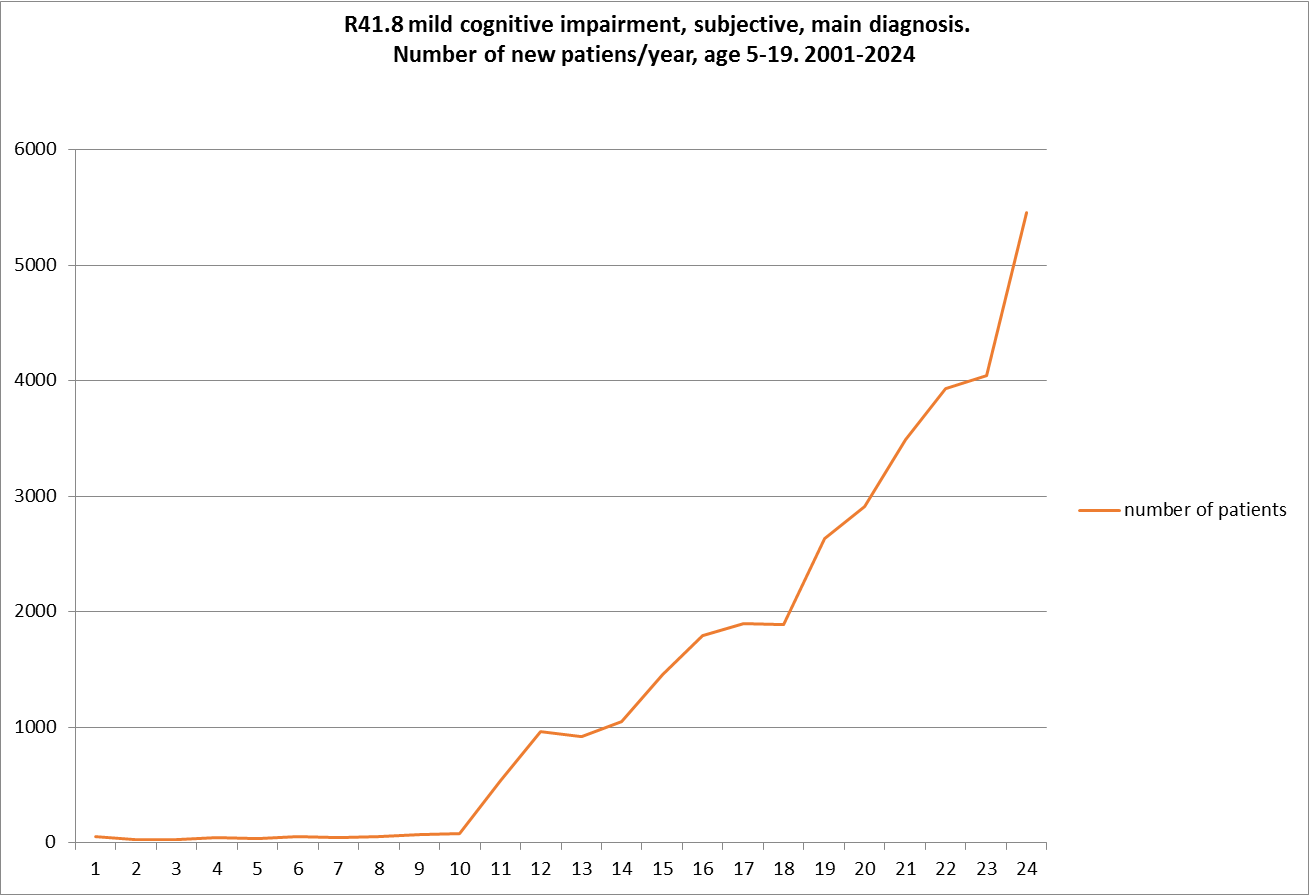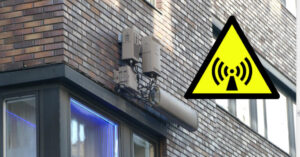In Norway and Sweden there is a sharp increase in children and teenagers with memory problems. In Sweden the number of children diagnosed with mild cognitive impairment increased tenfold between 2011 and 2024. Research has shown that radiation from wireless technology may impair memory. The increase in memory problems has coincided with increased exposure to this radiation.
On 13 June, Norwegian broadcaster NRK reported a sharp increase in registered doctor visits for memory disorders, even among children aged 5-14. For all ages, the number of doctor visits for memory disorders more than doubled between 2019 and 2024, but in the 5-14 age group, the number nearly tripled.
Richard Aubry White, a statistician and researcher at the Norwegian Institute of Public Health, stated that he had never before seen such a sharp increase in this health problem.
Marte Roa Syvertsen, a medical doctor at the neurological clinic and head of research at Drammen Hospital, told NRK that she is very concerned and that these are ‘disturbing figures’. Several curves relating to young people’s brain health are pointing in a negative direction, both for mental ill health and diagnoses such as ADHD and autism.
Memory problems also increasing in Sweden
The number of children, who have been diagnosed with memory problems (mild cognitive impairment, subjective), is also increasing in Sweden. The increase in the 5-19 age group began in 2011 according to the Swedish National Board of Health and Welfare’s statistics.
536 children aged 5–19 were diagnosed with mild cognitive impairment (R41.8) in 2011 but that number had increased over tenfold by 2024 when 5 456 children were diagnosed.
The diagram below shows the number of children who were diagnosed with mild cognitive impairment as their primary diagnosis during visits to specialized outpatient care between 2001 and 2024. Including children with mild cognitive impairment as secondary diagnosis the number were even higher: 6 472. Source: Swedish National Board of Health and Welfare.

Radiation from wireless technology impairs memory
Radiation from wireless technology, i.e. microwave radiation or radiofrequency radiation has been shown to cause memory impairment. Repeated research has shown harmful effects on memory in animal experiments. Repeated scientific studies have also shown that people exposed to elevated levels of this kind of radiation have an increased incidence of various symptoms, known as microwave syndrome, with impaired memory being one of the most commonly reported symptoms.
The effects on the brain function and nervous system in the form of for instance impaired memory, have been described for 50-60 years in the scientific literature, including from Eastern Europe, where occupational exposure to RF-radiation/microwaves was studied.
Soviet bloc countries reported that individuals exposed to microwaves frequently developed symptoms such as headaches, fatigue, dizziness, sleeping problems deterioration of intellectual functions (notably memory impairment). difficulty in concentration, emotional instability and labile cardiovascular function. (sources: 1; 2)
Already in 2003 a Swedish research group documented that mobile phone radiation damaged nerve cells in the brain of rats. The rats were of an age corresponding to teenagers. Professor Leif Salford warned that the effects observed might trigger Alzheimer’s. The same research group also found that the radiation caused impaired cognitive function and memory in the rats.
See further examples of the abundant research that has reported harmful effects on cognitive function and memory at the end of this article.
In the case studies on the health effects of 5G published to date, memory impairment is one of the more commonly reported effects. Other common symptoms observed in the studies on 5G health effects are sleep difficulties, fatigue, headaches, emotional instability and concentration problems. These are the same symptoms reported in the scientific reports 50-60 years ago.
Impaired memory, concentration problems, headaches and dizziness have also been repeatedly shown to occur to a greater extent among people living near mobile phone masts or base stations. For example, a study published in 2015 that examined students aged 13-16 in schools near base stations found that the group of students exposed to the highest radiation had significantly impaired memory when compared with a group students exposed to lower radiation.
A recently published study reported that people living near mobile phone base station and who were exposed to high radiation levels of 5-8 mW/m2 had higher proportion of symptoms, including memory problems. In this high exposure group over 92% reported memory problems.
5-8 mW/m2 is very much lower than the limits adopted in most countries that are recommended by the ICNIRP, the WHO, the EU and by the FCC. They allow exposure up to 10 000 mW/m2 and do not protect against the microwave syndrome symptoms, only acute heating effects observed within an hour of very high exposure. These extremely high limits are consequently questioned by many scientists for allowing harmful exposure and not sufficiently protect the public.
Increased exposure
People’s exposure to this type of radiation has increased very much during the same time period as the documented increase in cognitive impairment among children. During this time period, people, including children, have increased their use of mobile phones. In addition 4G and then 5G have been rolled out, leading to a sharp increase in exposure, particularly for those living in the vicinity of masts and base stations. Furthermore, WiFi and wireless computers have been introduced to an increasing extent in schools and in many homes. Overall, human exposure, including children’s exposure, has increased exponentially.
Studies documenting harmful effects on cognitive function:
Below is a list of studies showing harmful effect on cogntive function and memory:
Foerster M. et al.: A prospective cohort study of adolescents’ memory performance and individual brain dose of
microwave radiation from wireless communication. Environmental Health Perspectives, 2018;
http://dx.doi.org/10.1289/EHP2427
Ahmadi et al.; Exposure to GSM 900-MHz mobile radiation impaired inhibitory avoidance memory consolidation in
rat: involvements of opioidergic and nitrergic systems. Brain Res. 2018 Jul;
https://www.ncbi.nlm.nih.gov/pubmed/30030983
Fragopoulou et al. 2018; Hippocampal lipidome and transcriptome profile alterations triggered by acute exposure of
mice to GSM 1800 MHz mobile phone radiation: An exploratory study. Brain Behav. 2018
Junhttps://www.ncbi.nlm.nih.gov/pubmed/29786969
Varghese et al. 2018: Rats exposed to 2.45 GHz of non-ionizing radiation exhibit behavioral changes with increased
brain expression of apoptotic caspase 3. Pathophysiology March 2018.
https://www.pathophysiologyjournal.com/article/S0928-4680(17)30052-4/fulltext
Kumari et al.; Behavioral testing of mice exposed to intermediate frequency magnetic fields indicates mild memory
impairment. PLoS One. 2017 Dec 4;
https://www.ncbi.nlm.nih.gov/pubmed/29206232
Sharma et al.; Ten gigahertz microwave radiation impairs spatial memory, enzymes activity, and histopathology of
developing mice brain; Mol Cell Biochem. 2017 Nov; https://www.ncbi.nlm.nih.gov/pubmed/28470342
Kalafatakis et al. 2017; Mobile phone use for 5 minutes can cause significant memory impairment in humans. Hell J
Nucl Med. 2017 Sep-Dec; https://www.ncbi.nlm.nih.gov/pubmed/29324924
Muguntan et al.; Effects of Long Term Exposure of 900-1800 MHz Radiation Emitted from 2G Mobile Phone on Mice
Hippocampus- A Histomorphometric Study. J Clin Diagn Res. 2016 Aug;
https://www.ncbi.nlm.nih.gov/pubmed/27656427?dopt=Abstract
Ghadamgahi et al.; Memory loss risk assessment for the students nearby high-voltage power lines-a case study;
Environ Monit Assess. 2016 Jun; https://www.ncbi.nlm.nih.gov/pubmed/27194231?dopt=Abstract
Schoeni et al. Symptoms and Cognitive Functions in Adolescents in Relation to Mobile Phone Use during Night; PLoS
One. 2015; https://www.ncbi.nlm.nih.gov/pmc/articles/PMC4519186/
Zhao et al.; Neuritin reverses deficits in murine novel object associative recognition memory caused by exposure to
extremely low-frequency (50 Hz) electromagnetic fields; Nature Scientific Reports volume 5;
https://www.nature.com/articles/srep11768
Megha et al.¸ Effect of Low-Intensity Microwave Radiation on Monoamine Neurotransmitters and Their Key
Regulating Enzymes in Rat Brain; Cell Biochem Biophys. 2015 Se;
https://www.ncbi.nlm.nih.gov/pubmed/25672490?dopt=Abstract
Eris et al.; Effect of Short-term 900 MHz low level electromagnetic radiation exposure on blood serotonin and
glutamate levels; Bratisl Lek Listy. 2015; https://www.ncbi.nlm.nih.gov/pubmed/25665475?dopt=Abstract
Tang et al.; Exposure to 900 MHz electromagnetic fields activates the mkp-1/ERK pathway and causes blood-brain
barrier damage and cognitive impairment in rats. Brain Res. 2015 Mar;
https://www.ncbi.nlm.nih.gov/pubmed/25598203?dopt=Abstract
Saikhedkar et al.: Effects of mobile phone radiation (900 MHz radiofrequency) on structure and functions of rat brain;
Neurol Res. 2014 https://www.ncbi.nlm.nih.gov/pubmed/24861496
Qiao et al.; Reduction of Phosphorylated Synapsin I (Ser-553) Leads to Spatial Memory Impairment by Attenuating
GABA Release after Microwave Exposure in Wistar Rats; PLOSone April 2014;
https://www.ncbi.nlm.nih.gov/pmc/articles/PMC3990695/pdf/pone.0095503.pdf
Komaki et al.; Effects of exposure to an extremely low frequency electromagnetic field on hippocampal long-term
potentiation in rat.; Brain Res. 2014 May; https://www.ncbi.nlm.nih.gov/pubmed/24727530?dopt=Abstract
Razavinasab et al. 2014; Maternal mobile phone exposure alters intrinsic electrophysiological properties of CA1
pyramidal neurons in rat offspring.; Toxicol Ind Health. 2016 Jun;
https://www.ncbi.nlm.nih.gov/pubmed/24604340?dopt=Abstract
Quin et al.; [Effects of nano-selenium on cognition performance of mice exposed in 1800 MHz radiofrequency fields];
Wei Sheng Yan Jiu. 2014 Jan; https://www.ncbi.nlm.nih.gov/pubmed/24564105?dopt=Abstract
Xiong et al.; Changes of dendritic spine density and morphology in the superficial layers of the medial entorhinal
cortex induced by extremely low-frequency magnetic field exposure. PLoS One. 2013 Dec;
https://www.ncbi.nlm.nih.gov/pubmed/24376717?dopt=Abstract
Deng et al.; Effects of aluminum and extremely low frequency electromagnetic radiation on oxidative
stress and memory in brain of mice; Biol Trace Elem Res. 2013 Dec;
https://www.ncbi.nlm.nih.gov/pubmed/24158621?dopt=Abstract
About Ezz et al.: The effect of pulsed electromagnetic radiation from mobile phone on the levels of monoamine
neurotransmitters in four different areas of rat brain; Eur Rev Med Pharmacol Sci. 2013 Jul;17(13):1782-8;
http://www.ncbi.nlm.nih.gov/pubmed/?term=About+Ezz+mobile+phone
Deshmukh et al. Detection of Low Level Microwave Radiation Induced Deoxyribonucleic Acid Damage Vis-à-vis
Genotoxicity in Brain of Fischer Rats; Toxicol Int. 2013 Jan;20(1):19-24. doi: 10.4103/0971-6580.111549.
http://www.ncbi.nlm.nih.gov/pubmed/23833433
Shahbazi-Gahrouei et al.: Health effects of living near mobile phone base transceiver station (BTS) antennae: a report
from Isfahan, Iran; Electromagn Biol Med. 2013 Jun 19;
https://www.ncbi.nlm.nih.gov/pubmed/23781985?dopt=Abstract
Ntzouni et al.: Transient and cumulative memory impairments induced by GSM 1.8 GHz cell phone signal in a mouse
model; Elektromagn Biol Med; 2013 Mar;32(1):95-120. http://www.ncbi.nlm.nih.gov/pubmed/23320614
Strålskyddsstiftelsen: Faktablad om mobilmaster och hälsa 5
Lu et al.: Glucose administration attenuates spatial memory deficits induced by chronic low-power-density microwave
exposure; Physiol Behav; 2012; 106 (5): 631 – 637.
http://www.emf-portal.de/viewer.php?l=e&aid=20709
Khirazova et al.: Effects of GSM-Frequency Electromagnetic Radiation on Some Physiological and Biochemical
Parameters in Rats; Bull Exp Biol Med; 2012; 153 (6): 816 – 819
http://www.emf-portal.de/viewer.php?l=e&aid=21407
Zhao et al.: Relationship between cognition function and hippocampus structure after long-term microwave
exposure; Biomed Environ Sci; 2012 Apr;25(2):182-8. http://www.ncbi.nlm.nih.gov/pubmed/22998825?dopt=Abstract
Fournier et al.: Neurodevelopmental anomalies of the hippocampus in rats exposed to weak intensity complex
magnetic fields throughout gestation; Int J Dev Neurosci; 2012 Oct;30(6):427-33.
http://www.ncbi.nlm.nih.gov/pubmed/22867731?dopt=Abstract
Kitaoka et al.: Chronic exposure to an extremely low-frequency magnetic field induces depression-like behavior and
corticosterone secretion without enhancement of the hypothalamic-pituitary-adrenal axis in mice; Bioelectromagnetics;
2013 Jan;34(1):43-51. http://www.ncbi.nlm.nih.gov/pubmed/22753092?dopt=Abstract
Cammaerts et al.: GSM 900 MHz radiation inhibits ants’ association between food sites and encountered cues;
Electromn Biol Med; 2012 Jun;31(2):151-65.
http://www.ncbi.nlm.nih.gov/pubmed?term=22268919
Foroozandeh et al.: Toxic effects of 50 Hz electromagnetic field on memory consolidation in male and female mice;
Toxicol Ind Health; 2013 Apr; 29(3):293-9.
http://www.ncbi.nlm.nih.gov/pubmed/?term=Toxic+effects+of+50+Hz+electromagnetic+field+on+memory+consolidati
on+in+male+and+female+mice
Aldad et al.: Fetal Radiofrequency Radiation Exposure From 800-1900 Mhz-Rated Cellular Telephones Affects
Neurodevelopment and Behavior in Mice; Scientific Reports; 15 March 2012 ; Scientific Reports 2,Article
number:312,doi:10.1038/srep00312. http://www.nature.com/srep/2012/120315/srep00312/full/srep00312.html
Khorseva et al. Psychophysiological indicators for children using mobile phones. Communication 2. Results of four-
year monitoring; Radiats Biol Radioecol. 2011 Sep; https://www.ncbi.nlm.nih.gov/pubmed/22279774
Maskey et al.: Chronic 835-MHz radiofrequency exposure to mice hippocampus alters the distribution of calbindin
and GFAP immunoreactivity; Brain Research 2010
http://gnusha.org/~nmz787/biological%20radio%20research/Chronic%20835-
MHz%20radiofrequency%20exposure%20to%20mice%20hippocampus%20alters%20the%20distribution%20of%20calbi
ndin%20and%20GFAP%20immunoreactivity.pdf
Narayanan et al.: Effect of radio-frequency electromagnetic radiations (RF-EMR) on passive avoidance behaviour and
hippocampal morphology in Wistar rats; Upsala Journal of Medical Sciences; 2010; 115: 91–96.
http://informahealthcare.com/doi/pdf/10.3109/03009730903552661
Narayanan et al.: Spatial memory perfomance of wistar rats exposed to mobile phone; Clinics vol.64 no.3 São
Paulo Mar. 2009
http://www.scielo.br/scielo.php?script=sci_arttext&pid=S1807-59322009000300014&lng=en&nrm=iso&tlng=en
Bas et al.: 900 MHz electromagnetic field exposure affects qualitative and quantitative features of hippocampal
pyramidal cells in the adult female rat; Brain Res; 2009 Apr 10;1265:178-85.
http://www.ncbi.nlm.nih.gov/pubmed/19230827?ordinalpos=8&itool=EntrezSystem2.PEntrez.Pubmed.Pubmed_Result
sPanel.Pubmed_DefaultReportPanel.Pubmed_RVDocSum
Nittby et al.: Cognitive impairment in rats after long-term exposure to GSM-900 mobile phone radiation;
Bioelectromagnetics; 2008 Apr;29(3):219-32.
http://www.ncbi.nlm.nih.gov/pubmed/18044737
Abdel-Rassoul et al.: Neurobehavioral effects among inhabitants around mobile phone base stations;
Neurotoxicology. 2007 Mar; 28(2):434-40. Epub 2006 Aug 1; https://www.ncbi.nlm.nih.gov/pubmed/16962663
Wang et Lai: Acute exposure to pulsed 2450‐MHz microwaves affects water‐maze performance of rats;
Bioelectromagnetics 2000; https://onlinelibrary.wiley.com/doi/abs/10.1002/(SICI)1521-186X(200001)21:1%3C52::AID-
BEM8%3E3.0.CO;2-6
Lai et al.; Bioelectromagnetics. 1994;15(2):95-104; Microwave irradiation affects radial-arm maze performance in the
rat. https://www.ncbi.nlm.nih.gov/pubmed/8024608







